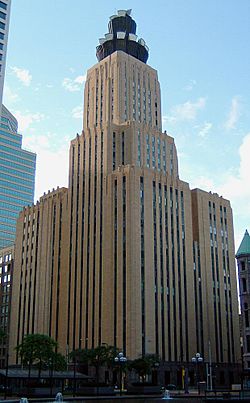CenturyLink Building facts for kids
Quick facts for kids CenturyLink Building |
|
|---|---|

Southeast view of the CenturyLink Building in Minneapolis
|
|
| General information | |
| Status | Complete |
| Architectural style | Art Deco |
| Location | Minneapolis, Minnesota |
| Address | 200 S 5th St |
| Coordinates | 44°58′39″N 93°16′0″W / 44.97750°N 93.26667°W |
| Completed | 1932 |
| Opening | 1932 |
| Height | |
| Antenna spire | 416 ft (127 m) |
| Roof | 346 ft (105 m) |
| Technical details | |
| Floor count | 26 |
| Design and construction | |
| Architect | Hewitt and Brown |
The CenturyLink Building is a famous skyscraper in Minneapolis, Minnesota. It was finished in 1932. For many years, it was the tallest building built in Minneapolis during the 1930s, 1940s, and 1950s.
Today, it's called the CenturyLink Building. But it used to have other names, like the Qwest Building and the Northwestern Bell Telephone Building. When it was first built, it was 346 feet (105 meters) tall. Later, in 1958, a microwave antenna "crown" was added. This made the building 416 feet (127 meters) tall! Another set of antennas was added in 1972. For a long time, it was the second-tallest building in Minneapolis. Only the Foshay Tower was taller. It is also a bit taller than its neighbor, Minneapolis City Hall.
The building has many cool details on its outside. You can see designs like electric bolts and a fancy bird above the main entrance. When it was being built, something unusual happened. An older Northwestern Bell building on the same spot was taken apart. Its steel frame was then used to help build the new, bigger structure. The building also got bigger on its west side in the 1940s.
Contents
History of the CenturyLink Building
Early Telephone Service in Minneapolis
Telephone service in Minneapolis started in 1878. The first phone switchboard was in the old city hall. It served only 11 phones! But more and more people wanted phones. By 1885, there were 775 phone lines. The main office moved to a bigger space in the city hall.
In 1890, the office had 1,700 lines. It had grown too big for the city hall. So, it moved to a new building on Fourth Street. By 1897, 3,000 people had phones. A new three-story building was built at Third Avenue South and Fifth Street. In 1908, two more five-story parts were added. Other phone offices opened outside downtown Minneapolis. By 1920, there were 96,000 phones in 14 different offices.
Building the Current Skyscraper
In 1920, a nine-story building was built at Third Avenue South and Fifth Street. This building was designed so it could be part of an even bigger structure later. By 1929, the phone company needed even more space. They had to rent six floors in another building.
Finally, the current CenturyLink Building was constructed. This happened after a careful study of what the phone company would need in the future. They decided to add space for the Minnesota main offices. This plan was both smart for money and looked good.
Inside the Building When It Was New
When the building first opened, the first floor was for customers. People could go there to pay bills or make long-distance calls. There were also public phone booths. The next 12 floors held all the telephone equipment. This included switchboards for long-distance calls. It also had equipment for local phone calls.
There were also break rooms and a lunch room for the phone operators. The 14th, 25th, and 26th floors were for building machinery. These are called mechanical floors. The tower, from the 15th to 24th floors, had the phone company's main offices. There were also three basement floors. These basements held power and heating equipment. They also had cable vaults for phone lines.
The building was 346 feet (105 meters) tall above the street. It also went 42 feet (13 meters) deep into the ground. It had 26 stories. Many of these stories were taller than in regular office buildings. This was because the phone equipment was very large. The building had 24,000 square feet (2,230 square meters) of floor space. About 1,000 people worked there.
Local Materials and Design
The CenturyLink Building was built using materials from Minnesota. The first floor has granite from Morton. The upper floors use limestone from Kasota. Cement from Duluth and steel from the Mesabi Range were used inside.
Minnesota architects designed the building. Minneapolis contractors built it. Other materials were also supplied by companies in Minnesota.
See also
 In Spanish: CenturyLink Building para niños
In Spanish: CenturyLink Building para niños

